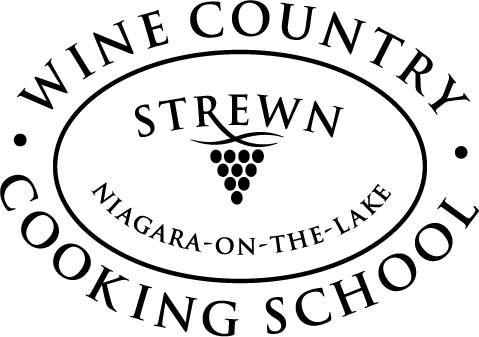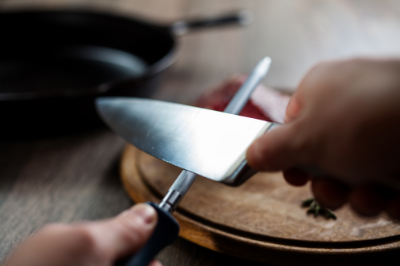Kitchen Knives. What You Really Need & How to Care for Them
Last time I counted there are more than 100 knives in the cooking school kitchen. Sounds like a lot but it really comes down to 20 sets of five knives. By “set," I mean five different knives put together to make a set rather than a pre-packaged one. So there now you know one of my principles: purchase the knives you need not the knives someone wants to sell you. While the right knives for your kitchen depends on the type of cooking you do, a few multi-purpose knives will handle almost everything.
- Chef’s Knife
Also known of a French knife, the chef’s knife is a multi-purpose knife designed to do many different tasks. This “King of the kitchen” can be used for mincing, slicing, chopping vegetables slicing meat and fish. At the school we have both 8-inch and 10-inch chef’s knives. Personally I prefer the large size (the more blade you have, the more there is to do the work) but many of our recreational cooks gravitate to the smaller version. - Slicer
Slicers are narrower, sometimes thinner, and more flexible than a chef’s knife. They are designed to cut smaller and thinner slices of meat (perfect for cutting medallions). - Serrated Knife
Also known as a bread knife, the serrated knife is perfect for cutting sandwiches, pastry crusts, tomatoes, peppers, citrus and foods that are firm on the outside and soft on the inside. The jagged edge can grip and penetrate without crushing the interior. Serrated knives are NOT effective for chopping. - Paring Knife
Perfect for “hand work” – smaller, delicate jobs where a slip of the knife might result in a cut, such as coring apples, hulling and slicing strawberries. It’s not a good choice for chopping or cutting hard vegetables. The most common “misuse” we see in class is using it to cut/chop fresh herbs – a chef’s knife is a more efficient choice.
“There is no such thing as the perfect knife. It should be well constructed but the feel in your hand is equally important.”
What’s Your Knife Style?
There are three main styles of knives:
- German (western-style) knives have a pronounced curved blade that tapers to a sharp tip
- Western-style Japanese hybrid knives, also called a gyuto, blades have less of a curve and taper to a very sharp tip
- Santoku – which has been described as the love child of a classic French chef’s knife and a Japanese cleaver - have a shorter body and snub-nosed blade with little dimples that run along the surface, (helps sticky food slide off the blade)
Knife balance is important but it means different things to people. Ask yourself:
- Does the knife feel comfortable and secure to hold?
- Is there enough clearance on the underside that you don’t bang your knuckles when you chop?
- Do you prefer a blade-heavy knife or one where the blade and the handle are the same weight?
The handle material is really a matter of personal taste and style: wood, plastic, composite plastic or steel are the most common choices.
The knife material is most likely to be hard steel (Japanese and hybrid-style), which retain edges longer but are tougher to sharpen, or soft steel, which need to be honed and sharpened more frequently. High carbon stainless steel blades do not discolour or stain, and maintain a sharp edge for a reasonable time. Ceramic knives may be in vogue now (with their great bright colours) but are not recommended for most uses because of their fragility.
Knife Care and Maintenance
Don’t throw your money away by buying good quality knives and then not looking after them!
Here are a few Dos and Don’ts to follow:
- Hand wash the blade and dry it thoroughly before putting away
- NEVER put knives in the dishwasher
- Store knives separate from other kitchen utensils so they don’t bump around in a drawer and become dull
- Only cut or chop on a wood, plastic or rubber cutting board; hard materials such as glass, ceramic (including dinner plates!) or granite will dull knives
- Use a honing steel (rod) to keep a sharp cutting edge (you can do this every time before you use a knife as it realigns the microscopic teeth on the blade rather than sharpening the knife)
- Don’t hone serrated knives as the teeth of the rod won’t glide along the blade
- Once a year use an electric knife sharpener (the knives at the school get a lot of use and some abuse and we’ve had good success with the Chef’s Choice Professional Sharpening Station 130) or have your knives professionally sharpened
And yes it is true: you are less likely to cut yourself when you use a sharp knife because you use less force.




